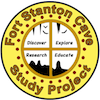
Directors of the Fort Stanton Cave Study Project
 |
Directors of the Fort Stanton Cave Study Project |
About Us Following our May 18, 2022 BoD meeting, John Cochran set up this photo of the current BoD members. Looking south down the valley, the Capitan Mountains are in the background. Government Spring, out of sight beyond the hill on the right, is the resurgence of the Snowy River Passage. (L-R John Cochran, Wayne Walker, Steve Peerman, John Moses, Ron Lipinski, Pete Lindsley and John Lyles)
|
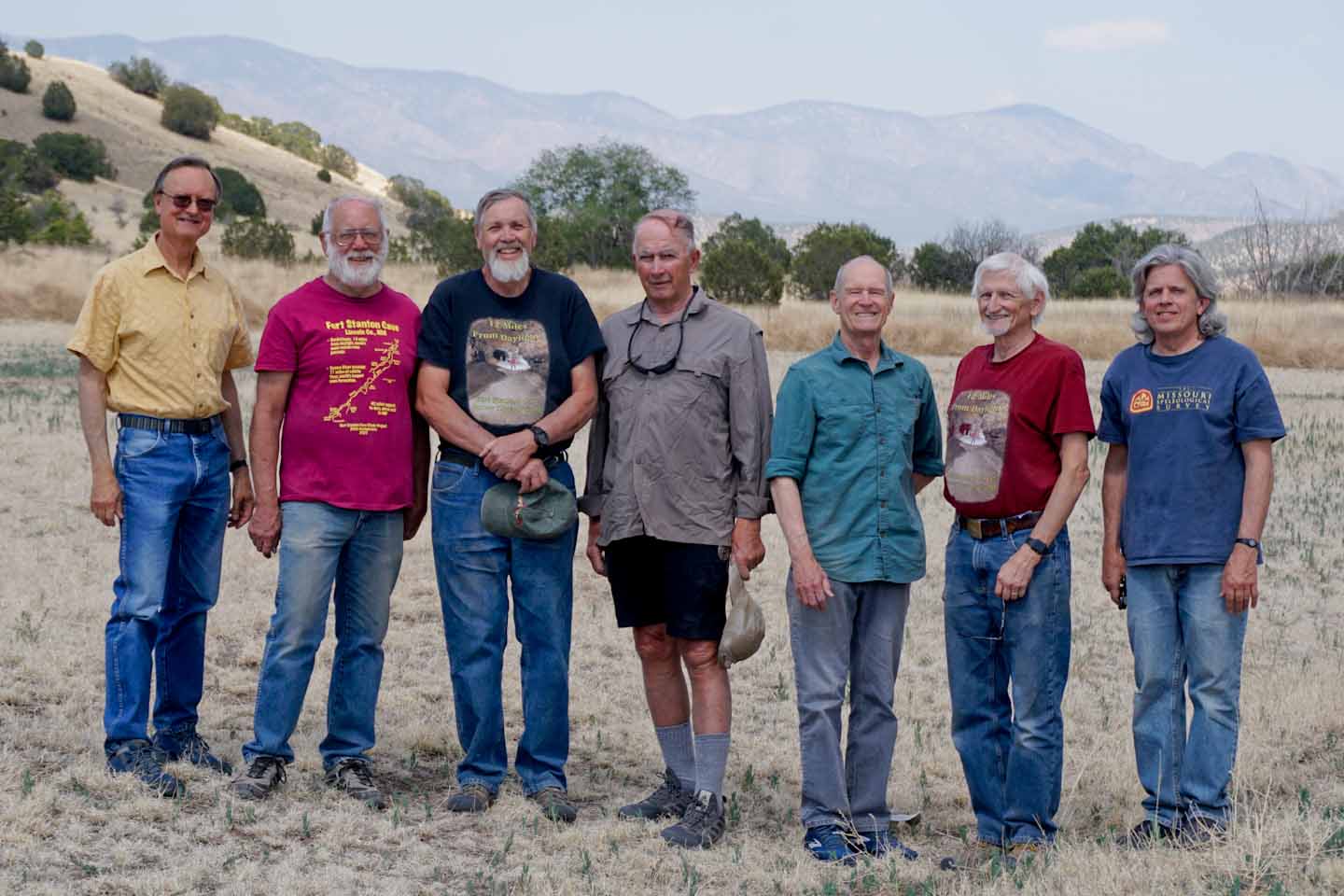 |
John R. Cochran(NSS 19398 CM)
|
John moved from Arkansas to Las Cruces in 1977 to attend New Mexico State University. The adventures began that fall when he joined the student grotto led by Steve Peerman. We drove 1960’s vehicles at a-mile-a-minute to world-class caves in the High Guads like Virgin, Cave of the Madonna, Ogle and Three Fingers. There were additional caving adventures in the Black Range, the Caballo’s, the Chiricahua’s and especially the El Malpais. John enjoyed caving and he became an experienced cave photographer. John was the photographer for 4 week-long cave restoration camps in Carlsbad Caverns NP. With the late Mike Goar, John participated in 4-day camp trips in Lechuguilla Cave, camping roughly 1200 vertical feet below the surface. John was also the photographer on the July 2, 2003 Snowy River Assessment trip through Priority Seven – and he was one of the first people to walk on Snowy River. With demanding work and a young family, John was absent from active caving from 2004 to 2019, when he retired and rejoined the caving community. Since rejoining, John has caved in Fort Stanton Cave and its Snowy River, and he has supported many cave restoration trips in the High Guads (e.g., Pink Dragon, Cottonwood and Virgin). John has a MS in Civil Engineering and a BS in Geological Engineering. In his early career he worked for three different federal agencies. In his late career, he worked almost 30 years for Sandia National Laboratories in Environmental Restoration and helping others manage their radioactive wastes. John is currently the 2023 FSCSP Secretary. |
Pete Lindsley(NSS 5566 CM-FE)
|
Pete has maintained a strong interest in caves and caving for the past 59 years. He has contributed to several major cave surveys, including organizing the teams working on survey of caves between 10 and 20 miles in length. With a strong interest in photography, he began building an extensive collection of photographs of caves including Fort Stanton Cave. A native Texan, his first visits to wild New Mexico caves were made in the 1960s, when he started work in the Guadalupe caves in the National Parks, National Forests, and on adjacent BLM lands in both southern and central New Mexico. He teamed with other cavers in New Mexico, Arizona, Colorado, and Texas in the mid-1960s to form the Guadalupe Cave Survey (GCS), with emphasis on survey of new passages in Carlsbad Cavern and several other Guadalupe caves. In the late 1960s he began working with the Cave Research Foundation (CRF) in surveying Mammoth Cave, Kentucky, the longest cave in the world. After merging the smaller GCS group with the larger (501.c.3) Cave Research Foundation in 1971, both areas benefited from the cross-coupling of cavers and scientists. He served 18 years on the CRF Board of Directors, including several years as the CRF President and Secretary. He ran the CRF Fitton Cave (Arkansas) Survey Project from 1985 to 2000. He is the current FSCSP Treasurer, and a Director of the organization since 2010. Past photography projects involve panorama type photos in Snowy River and elsewhere, improving the process to obtain "wall paper" type images for integration with Dr. Ron Lipinski's Caver Quest - Fort Stanton computer simulation project. Current projects include photogrammetry, working closely with Ron Lipinski on a hydrology discharge measurement process, and managing the Data Logger Project with the Fort Stanton Hydrogeology Working Group. His professional background as an MSEE and Professional Engineer emphasized design and development of microwave antennas for both consumer and government applications. With 45 years of microwave experience at Texas Instruments and Raytheon, he saw many of his teams' designs achieve state-of-the-art performance and numerous sensor systems were fielded in production quantities. Retiring in 2007, he moved to northern New Mexico. He is currently the FSCSP.org Webmaster and Treasurer. Recent projects include joint editing (with Lee Skinner) and publishing of the FSCSP book 12 Miles From Daylight published in June, 2017, and a lengthy report on A Decade of Data Logging in Fort Stanton Cave and Snowy River. He is also the co-editor of annual FSCSP Calendars featuring recent photos from teams working in the cave. Pete is currently the FSCSP.org Webmaster and Treasurer. |
Ronald J. Lipinski(NSS 23791 CM) |
Ron moved to New Mexico in 1977 and first visited Fort Stanton Cave in the early 1980s. From 1979 to 1988 Ron was active with the Cave Research Foundation Guadalupe Escarpment Area, serving as personnel manager for much of that time. He surveyed the back areas of Carlsbad Caverns, discovered 1000 feet of virgin passage, and assisted in the cartography of the cave. From 1988 to 1991 Ron surveyed in Lechuguilla Cave. He has been active in the Fort Stanton Cave Study Project since 2008. In 2010, when White Nose Syndrome caused the closure of many caves, and when it became apparent that very few people would be able to access Snowy River, Ron began to build the Caver Quest software. The intent of Caver Quest is to bring Fort Stanton Cave to a larger audience via a 3-D interactive simulation of the cave. Caver Quest has proven to be a very useful public outreach tool and is especially popular with grade school and high school ages. Ron received a Certificate of Merit from the National Speleological Society in 2016 for his work in developing the software. He is currently the Vice Chairman on the FSCSP BOD, and is one of the contributors to the FSCSP book 12 Miles From Daylight published in June, 2017. Ron has a Ph.D. in nuclear engineering and has served 38 years at Sandia National Laboratories in the areas of nuclear reactor safety, strategic defense, electron beam propagation, high energy lasers, and launch safety for nuclear batteries on NASA missions. Most recently, his team at Sandia performed the safety analysis to obtain launch approval for the Mars Science Laboratory mission in 2011. He retired from Sandia in 2015. Ron is currently the 2023 FSCSP Project Director. |
John Lyles(NSS 19871 FE)
|
John Lyles has been an active cave explorer for over 45 years. He started caving while studying at Virginia Tech and explored caves in the Appalachian region. His career took him to Illinois where he explored caves in nearby Missouri. Another move connected John to caves in Pennsylvania, Maryland and again in both Virginia's. He came to Los Alamos in 1992 and became associated with project caving in the extraordinary caves of New Mexico. While caving in the Guadalupe's, John focused on one project that he has continued for 28 years. He made a number of new discoveries in 150+ mile Lechuguilla cave at Carlsbad Caverns National Park, participating on 39 underground camping expeditions, numerous weekend trips and on several filming projects underground for Planet Earth and the One Strange Rock series. He continues to bring fresh cavers into this project to ensure it keeps going into the future. John joined the FSCSP in 2003 and has been active in most of the exploration of Snowy River. He was on the teams that found Crystal Creek in the north end of Snowy River, Midnight Junction in the south, and both ends of the Metro passage. John has continued to add discoveries to the known cave by leading mapping expeditions, digging into new areas, and assisting in carrying out scientific goals. He contributed to chapters in the book 12 Miles from Daylight. He has authored numerous caving articles and technical reports in NSS News, The Cave Radio and Electronics Group Journal (UK), Speleonics, Rocky Mountain Caving, Southwestern Cavers, and a special edition of the Boletin Geologico Y Minero. John is a Fellow of the NSS, an Honorary member of the Southwest Region, a recipient of the Fort Stanton Caving Legend award (2017) and the NSS Lew Bicking award for exploration. Over the years he has held leadership positions in the caving community as chairman for several caving clubs, the southwestern region chapter of the NSS, and currently he is Vice President of the Cave Research Foundation as well as FSCSP. He is currently the project leader of the GypKap project. Having a BS degree in Electrical Engineering, he designs equipment for particle accelerators at Los Alamos National Laboratory. His interest in radio electronics has piqued his interest in cave communications and he developed the BuecherNet data system to transport sensor information out of the cave. As a cave owner of the entrance to Edgewood Caverns, he understands landowner issues as well as how to safely manage exploration. |
John L. Moses(NSS 7009 CM)
|
At the April 2012 meeting of the Fort Stanton Cave Study Project, John Moses was elected to the board of directors. "It is quite an honor to have been invited to join the project board, " said Moses, "as, even after decades of study, discoveries in Fort Stanton Cave continue to amaze cave explorers and scientists alike." A lifelong cave explorer and conservationist, he has served as International Secretary of the National Speleological Society since 1997 and was secretary on the organizing committee (NSS certificate of merit) of the 15th International Congress of Speleology. A member of the Mesilla Valley Grotto, over the years he has also belonged to Greater Houston, Windy City, Michigan Interlakes, Nittany and Pittsburgh Grottos of the NSS. Among his more interesting past projects, he was US team leader of the (then) Soviet - American expedition to Snezhnaya Cave in the Abkhazian Autonomous Zone of the Republic of Georgia. That cave is among the world's deepest. Moses retired in 2011 as General Superintendent of Texas State Parks in El Paso, which included Hueco Tanks State Park & Historic Site, Franklin Mountains State Park, Magoffin Home Historic Site and Wyler Aerial Tramway. He joined Texas Parks and Wildlife Department in 2000 as Park Superintendent at Hueco Tanks, following a 30-year career in international mining and petroleum. While living in the Franklin Mountains in northeast El Paso, he is past chair of the City’s Quality of Life/ Tourism Cabinet, member of the Mayor’s Lyceum, El Paso County Eco-Tourism Committee and board member of the Frontera Land Alliance. He received an MBA from the University of Chicago and BS degree in mineral economics from Pennsylvania State University. Commissioned as an officer, he served in U.S. Army ordnance and combat engineer units. He is a certified (Texas) emergency medical technician. He currently resides with his wife Anne in Santa Fe. |
Stephen S. Peerman(NSS 16158 RL CM-FE)
|
Steve was born in New Mexico and began his caving activities in the early 1960s at Endless Cave and several gypsum caves. He first visited Fort Stanton Cave in 1974. He became the Chairman of the Southwestern Region of the National Speleological Society in 1976, and was involved with both cave digging and survey projects in New Mexico and southeastern Arizona. In 1986, he was the Program and Registration Chair of the National Speleological Society Convention in Tularosa, NM. Shortly afterwards, he was one of the organizers of the New Mexico Gypsum Karst Project (GypKaP), and directed the project for five years, for which he was later awarded the NSS Certificate of Merit. He was later named a Fellow of the National Speleological Society. His work on the FSCSP continued in 2004 and following his professional retirement in 2005 he has devoted much of his time as assistant director of the FSCSP. In 2010, he was instrumental in reorganizing the Fort Stanton Cave Study Project as a formal non-profit entity. In October 2010, Steve was elected by the board to be the Project Director in 2011, and continues to successfully organize and field several special trips in addition to the "standard" three week-long expeditions the FSCSP holds every year. Steve is one of the contributors and authors of the FSCSP book 12 Miles From Daylight published in June, 2017. His professional background consisted of a career teaching Mathematics and Computer Science at Las Cruces High School. In the 1990s he helped organize and was a member of the Board of Directors of the New Mexico Council of Computer Users in Education. In the late 1990s he became involved with the Adventures in Supercomputing program administered by Sandia National Laboratories. Eventually he became Chair of the Board of Directors of that organization, shortly before it merged with the New Mexico High School Supercomputing Challenge, administered by Los Alamos National Laboratories. Retiring from many years as the Project Director, Steve is currently the 2023 FSCSP President. |
Wayne C. Walker(NSS 15122 RE)
|
Wayne took over the duties of FSCSP President in October, 2016. He has been involved with various cave projects since 1968 in New Mexico including the Guadalupe Cave Survey (GCS), the Cave Research Foundation (CRF), and the FSCSP. Some of his early caving included extensive cartography work and lead pushing in Carlsbad Caverns National Park with the GCS and later the CRF. He also has worked extensively in Fort Stanton Cave doing both cartography work and digging. In 1972, he returned to Texas to work on his Masters degree in Physics at Texas A&M (1978). While at TAMU, he was one of the organizers of the Aggie Speleological Society Cave Club. After his graduate work, he moved to San Antonio, Texas and became a member of Bexar Grotto and participated in extensive work in central Texas and in Mexico. He was one of cavers that organized and conducted the first two National Cave Rescue (NCR) Symposiums which were held in San Antonio. As a result of his work with NCRS, he was chosen to be Co-Leader of one of the NCR’s first international cave rescues, this being in Mexico. In 1983, his work returned him to New Mexico (with brief forays over the years to California and Alabama) where he resumed his activities in the state and in particular, Fort Stanton Cave. In 1986, he was Campground Co-Chairman for the National Speleological Society Convention in Tularosa, NM. He is also a charter member of the New Mexico Gypsum Karst Project (GypKaP). Recently Wayne has been involved as a volunteer and state officer with the Order of the Eastern Star, which is also a 501.c.3 organization. Throughout his caving career, his professional scientific background has encouraged him to better understand the geologic, hydrological, and biologic processes present in caves. As a result, he has been working with numerous scientists to study Fort Stanton Cave since his first introduction to the cave in 1968. In 2010, he was instrumental in reorganizing the Fort Stanton Cave Study Project as a formal entity and is a Charter Board Member of that organization. He is currently the FSCSP President and Assistant Project Director. Retiring as FSCSP President, Wayne is currently the 2023 Vice President. |
FSCSP Directors Emeritus:
John J. Corcoran, III(NSS 7165 CM-FE)
|
|
John retired from the FSCSP Board in October, 2016, and was named as Director Emeritus. He continues working on parts of the cartography project and is heavily involved in the publication of the FSCSP book 12 Miles From Daylight published in June, 2017. John moved to New Mexico in 1949 and began his caving activities in 1960. First visiting Fort Stanton Cave in 1962, he quickly became involved in 1964 as one of the founding members of the Guadalupe Cave Survey (GCS), which focused on the caves and karst of Carlsbad Caverns National Park. He started an informal study project at Fort Stanton Cave (FSC) that same year doing exploration and biological inventory; that project continues to this day as the Fort Stanton Cave Study Project. His professional background at companies including Northrop Grumman, TRW, BDM, Ford Aerospace and others as a Computer Programmer / Analyst / Software Engineer & Architect allowed him to retire in 2007. John acted as the FSCSP Project Director through 2010, and as our President through October 2016. Acting as our Chief Cartographer through 2015, John was very busy attempting to keep our maps of both Fort Stanton Cave and numerous smaller caves up to date. |
Lynda A. Sánchez
|
Lynda retired from the FSCSP Board in October, 2019, and was named as Director Emeritus. Author/historian and retired educator, Lynda Sánchez, has called historic Lincoln town near Fort Stanton Cave her home for more than three decades. She has taught at the high school and college level (Spanish, history and anthropology). Her time in the Peace Corps in South America, her archaeological field work at Mesa Verde, Colorado and in Mexico and for the Blue Creek Maya Research Project in Belize, as well as having New Mexico author, Eve Ball, as her writing mentor, all greatly influenced and guided her to the colorful mosaic representing folk heroes, legends and the colorful history of the southwest. She has served on the BLM Resource Advisory Council, the Lincoln County Historical Society, the Fort Stanton Development Commission, taught teacher workshops (funding from the National Science Foundation) using the science of archaeology as the means to inspire youngsters in math, science, language arts, and biology, and worked in obtaining a grant for an archaeological survey of the Fort Stanton lands. She is a member of Western Writers of America and freelances for Arizona Highways, New Mexico Magazine, True West and others. She speaks before numerous groups and is an advocate for veterans' legacy in New Mexico. Lynda is the recipient of many awards related to these fields including a "cavalry sword" for work on preserving Fort Stanton, and True West's 2007 Best Preservation Project in the Nation award. Her interest in the Fort Stanton Cave Study Project occurred while writing her book Fort Stanton, Legacy of Honor, Tradition of Healing. Her particular interest in Fort Stanton Cave began with research for a chapter about the fascinating history and the dedication of the men and women who have explored the cave for decades. She is a Director of the organization and also acts as our primary Public Relations Liaison which includes writing news releases, caver profiles and caving related articles, and acting as the local Lincoln County spokesperson for the group. Lynda is a major contributor to the FSCSP book 12 Miles From Daylight published in June, 2017. |
|
Lee H. Skinner(NSS 4807 FL)
|
Lee H. Skinner is a retired scientific computer programmer who worked for Texas Instruments, BDM Corporation, Spectra Research Institute, Control Data Corporation, and ETA Systems. He also wrote the HP-35 Math Pac for Hewlett Packard Corporation. Lee joined the Board in April, 2012, and retired as Director Emeritus in 2021. He started caving in 1957 while at the University of Florida. He worked for the National Park Service at Mammoth Cave National Park in 1960 as a tour leader. In 1961 he started caving in the Guadalupe Caves and Fort Stanton Cave in New Mexico while stationed in the U.S. Army at Fort Bliss, Texas. He actively explored Fort Stanton Cave on an average of two to three weekends a month, digging into and exploring several new areas (Heinz Schwinge Hall, Lincoln Caverns, Don Sawyer Memorial Hall) until the mid 1970s, and during that time became known as Mr. Fort Stanton to other cavers. He was also on the discovery trip of the Guadalupe Room in Carlsbad Cavern and found the Wonderland section of Cottonwood Cave in the Guads, the Mystery Three section of Mystery Cave, Minnesota, as well as parts of Big Mutha Cavern in Texas, and the entrance to Cactus Cave south of Fort Stanton. He was the FSCSP Board Secretary and was a major contributor and editor for the FSCSP book 12 Miles From Daylight published in June 2017. Lee wrote and continues to update the Fort Stanton Cave Chronology, an exploration history of this world-class cave. The picture at the left shows Lee at Cactus Cave in 2011, illustrating with his right hand the original size of the small blow hole that was no bigger than a quarter, now one of the FSCSP dig projects. |
Previous FSCSP Director Photos
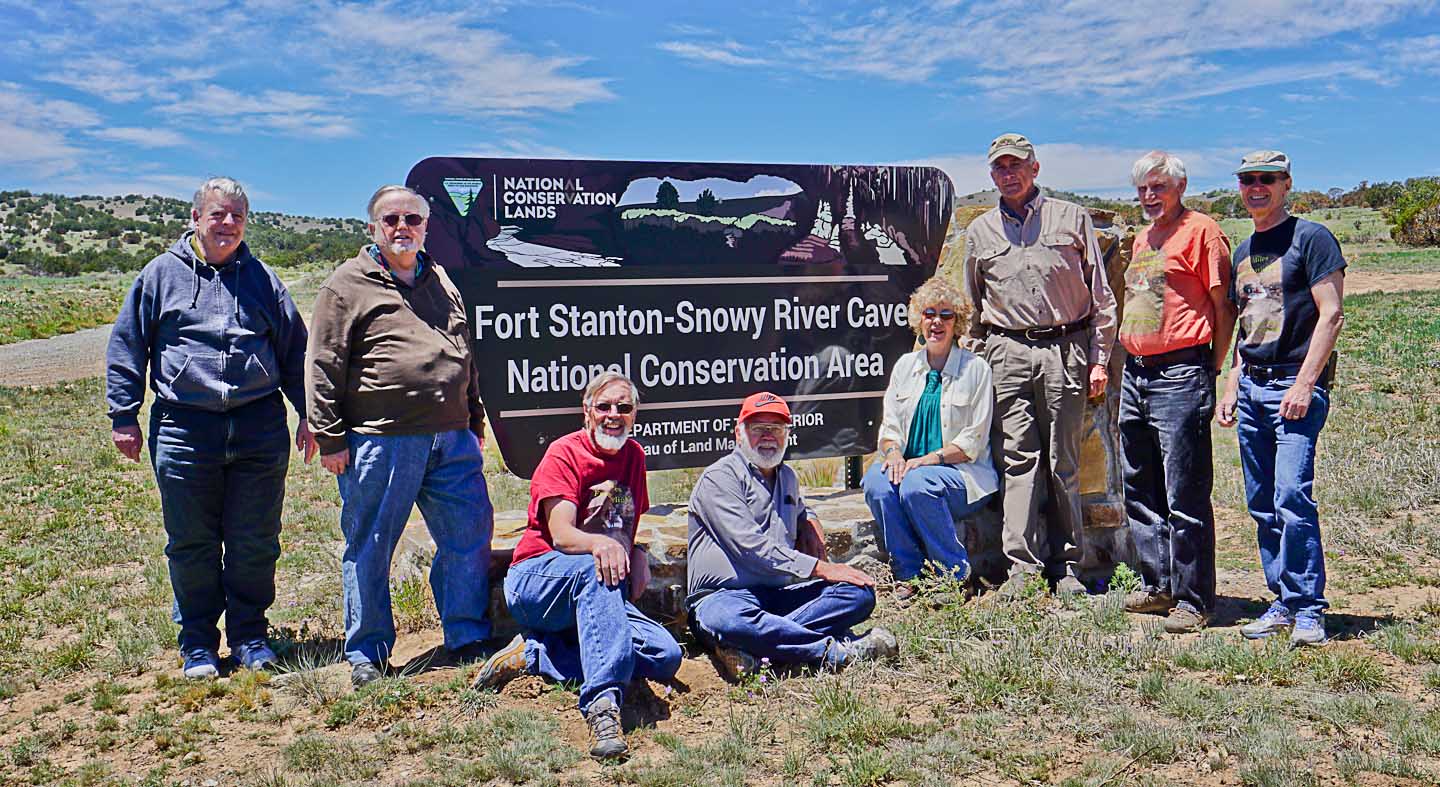 |
It was a sunny May 17, 2017 afternoon at the Fort Stanton - Snowy River Cave National Conservation Area when Knutt Peterson took this photo of the Board of Directors. |
(L-R John Corcoran, Lee Skinner, Steve Peerman, Wayne Walker, Lynda Sanchez, John Moses, Pete Lindsley, Ron Lipinski |
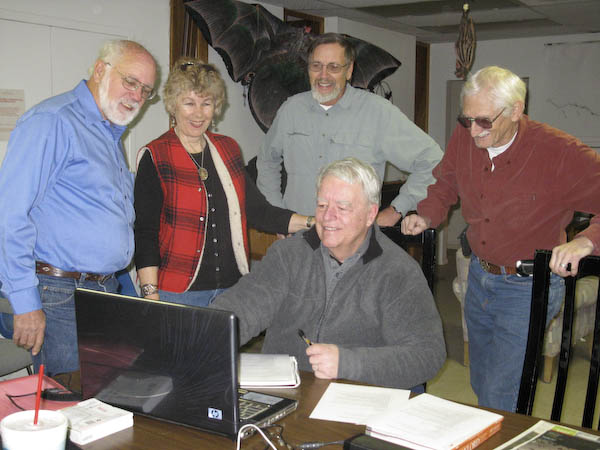 |
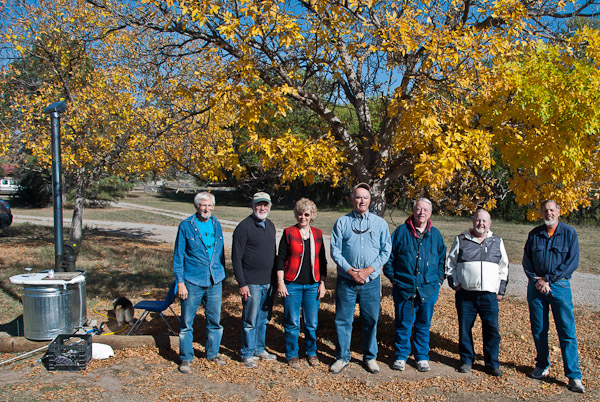 |
|
January 2011 Board of Directors MeetingThe directors are enjoying a preliminary view of Ron Lipinski's adaptation of a computer game interface into a visual "walk" down the Snowy River Passage, which now has expanded into Caver Quest.L-R: Wayne Walker, Lynda Sanchez, Steve Peerman, John Corcoran & Pete Lindsley |
October 2012Mug shot after the 2nd Board meeting of 2012. (L-R) are Pete Lindsley, Wayne Walker, Lynda Sanchez, John Moses, John Corcoran, Lee Skinner and Steve Peerman. The group is standing next to an early iteration of a hot water decon tank being used by the Project to replace the previous chemicals used for WNS decon before and after cave entry. |
|
Just in case you happen to have some old historic information or photos of Fort Stanton Cave, some potential cave locations nearby on your property you would like to contact us about, or just want to write or send us an item that won't go through the e-mail, please use our corporate address in Placitas, New Mexico shown below: |
FSCSP 1 Whispering Winds Trail Placitas, NM 87043-8861 |
![]()
Rev. 1-27-2023 |
Comments to the webmaster |
Contact the FSCSP President |
Contact the Project Director |